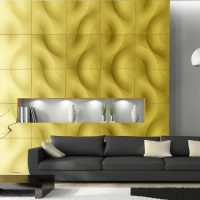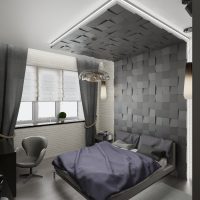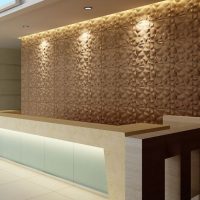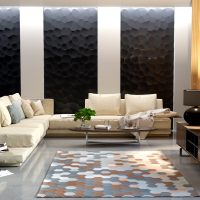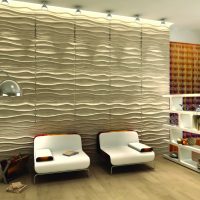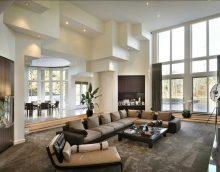3D panels in the interior: photos, installation, pros and cons
Modern finishing materials are striking in their diversity, but the designers still manage to surprise us, offering the latest fresh solutions. One of the latest trends is 3D panels in the interior. The unique building material used for wall decoration opens up unlimited horizons for room decoration.

Room design with 3D panel

3D bedroom interior

Gorgeous large 3D panel in the interior
Content
What are the panels
Manufacturers offer a wide range of 3d plates, because wall panels are made of various materials, which have their own advantages and disadvantages.
- Gypsum panels. Flexible and plastic gypsum allows you to realize a wide variety of patterns and textures, and a wall made up of several such panels seems solid, since the gaps between them can easily be discreetly covered with the same gypsum. In addition, this material is colorable. The disadvantage is the significant weight of gypsum panels compared to plastic or MDF.
- Plastic panels. Considered a budget option. In addition, they are moisture resistant and lighter. Wall panels made of plastic can be painted, and their installation is quite simple: they are attached to the wall with glue or a metal frame. The disadvantage is their flammability, because of which it is impossible to use 3D panels for walls in the interior of the living room directly next to the fireplace.
- MDF panels. They are made from wood fibers by gluing. The material is environmentally friendly and reliable, but much cheaper than wood. It features high performance and reliability. It is used for decoration of rooms with humidity not more than 80%. Embossed panels of pressed wood fibers are attached to the wall using brackets. The advantages include high noise and heat insulation. MDF wall panels can be painted and laminated. Of the minuses, we highlight the need for careful care of them, since over time it somewhat loses its appearance.
- Bamboo panels. Natural wood materials are also popular. Most often used for the manufacture of volumetric decorative bamboo plates. Low cost, environmental friendliness, ease of installation and excellent appearance open up many opportunities to use bamboo 3d panels in the interior. However, unfortunately, such panels are short-lived and have low moisture resistance, therefore they are not very suitable for a bathroom or kitchen. Usually they are used in bedrooms or living rooms.
- Aluminum panels. A volumetric image on the surface of aluminum plates is obtained by the method of perforation, and on top they are coated with a special film that serves to protect the panel from corrosion. Therefore, aluminum wall panels are quite moisture resistant. In addition, they are resistant to fire and very durable. Therefore, it is permissible to use aluminum 3d panels for walls in the interior of the living room with a fireplace. This material does not require special care and is practically not contaminated, but such luxury is worth it accordingly.
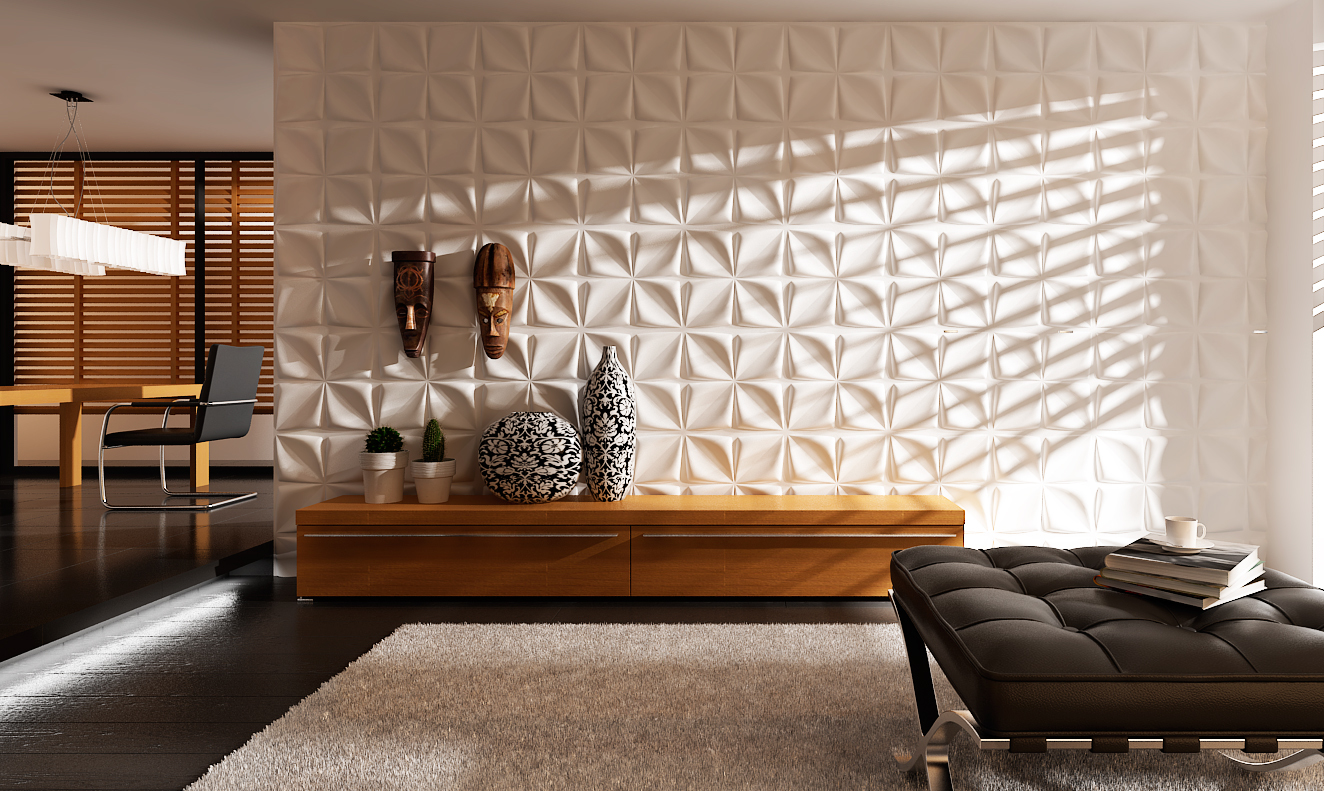
Room interior with 3D panel

Room interior with 3D panel

3D panel squares
In order to make it easier to determine the choice of panel material for your interior, we present their comparative table:
|
Gypsum |
Plastic |
MDF |
Bamboo |
Aluminum |
|
|
Ease |
– |
+ |
+ |
+ |
+ |
|
Moisture resistant |
– |
+ |
+ |
– |
+ |
|
Fire resistance |
+ |
– |
– |
– |
+ |
|
Durability |
+ |
+ |
– |
– |
+ |
|
Cost |
Depends on the complexity of the picture |
Average |
Average |
Low |
High |
|
Installation |
Screws |
Glue or metal frame |
Brackets |
Glue |
Special Profiles |

3D living room interior
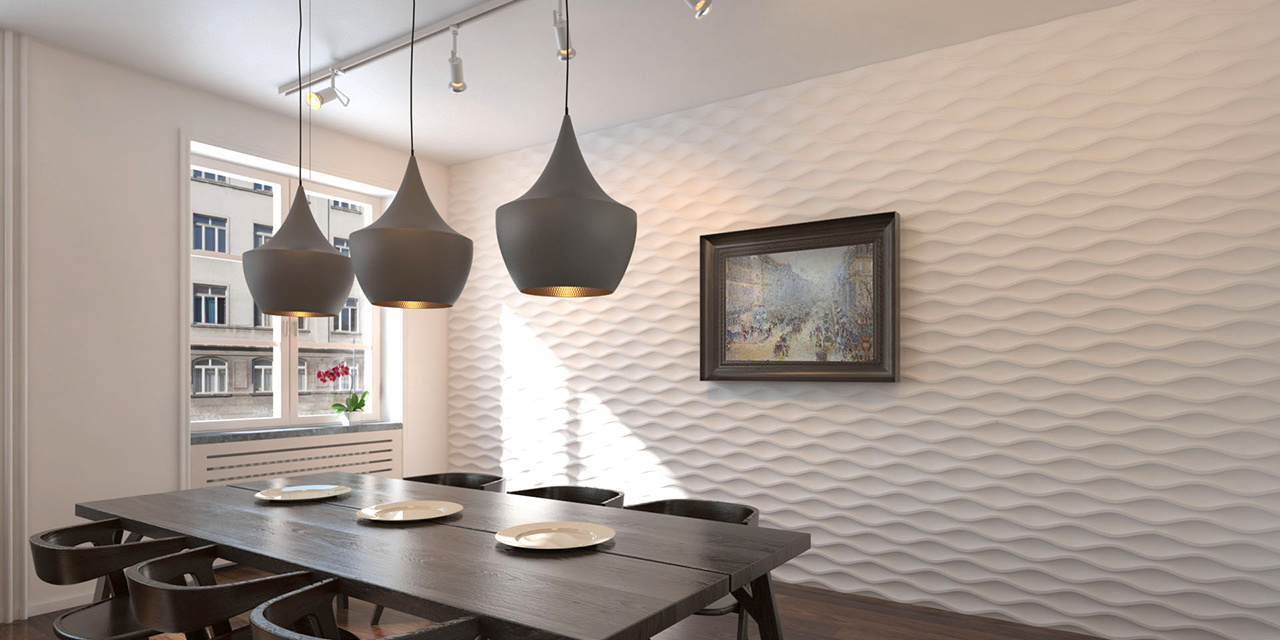
Living room with 3D panel

3D panel bedroom
Pros of 3d panels
- Universality. The possibilities of using embossed panels are almost endless. They are used for decoration or as partitions for zoning rooms. Thanks to volumetric plates, you can hide the imperfections and bumps of the walls, hide insulation or various communications.
- Originality. Decorative wall panels can create a bold design and unique appearance of the room. We began to use such finishing materials relatively recently, so not everyone managed to evaluate their advantages, and 3d wall panels in the interior of the apartment will become quite an unusual solution that will definitely surprise your guests.
- Durability. Most wall panels are made from high quality materials.
- Usually they are moisture resistant, durable and resistant to mechanical stress, which guarantees a long service life of the panels.
- Ease of installation. Installation of panels does not require additional preparations, as well as special tools or skills. To install the slab, you do not need to bring the wall to an impeccable condition, because the installation is made even on uneven surfaces. You can decorate the walls of the room with decorative plates without involving professionals with glue or liquid nails.
- Heat and sound insulation. Volumetric drawings on panels made of various materials serve for decoration, but are also able to play the role of insulation or soundproof partition.

Wavy 3D panel in the interior of the room

Room interior with 3D panel

Large room with a beautiful 3D panel
Cons of 3d panels
- Difficulty perception. It is recommended that relief panels be placed on only one wall or part of it. Otherwise, they can overload the interior, as well as bore a person.
- The need for regular cleaning. The volumetric pattern on the walls will accumulate dust on itself, and, therefore, require constant cleaning. When installing 3D panels in the room, you need to be completely sure that you can provide such care. Otherwise, the accumulated dust will not only spoil the effect of the three-dimensional image, but can also cause allergies.
- Stylistic features. Relief panels - this is a rather complicated effect, which requires compliance with the stylistic unity of the room. In many interiors, such a decision will look too elaborate or inappropriate.
- Difficult to replace. If one panel fails, it will be quite difficult to find a replacement, so it is better to stock up on a few extra plates in advance.

Unusual 3D panel in the interior of the room
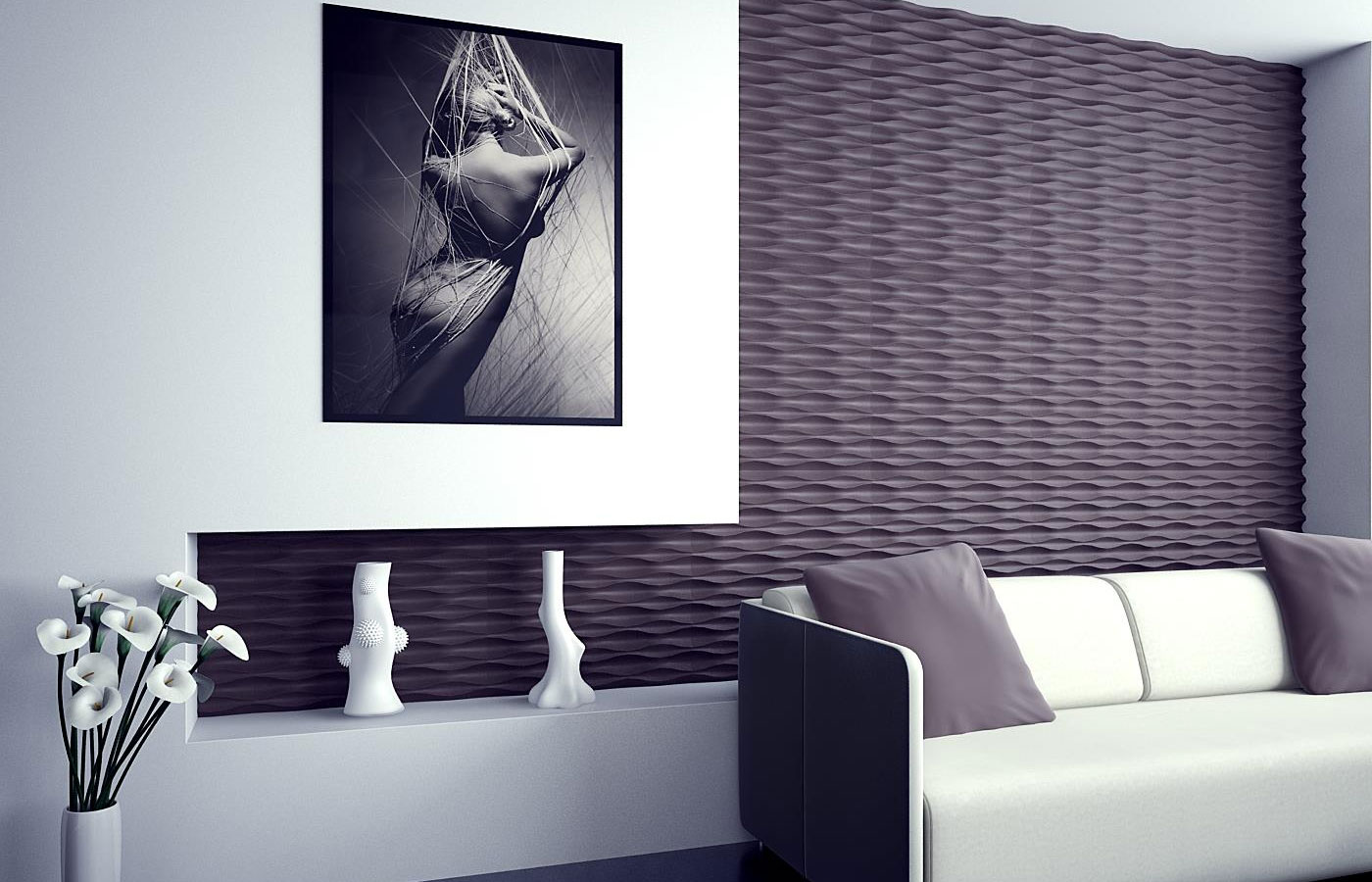
Room design with 3D panel

Bright 3D panel in the interior of the room
Application options
Three-dimensional technologies are actively being introduced into interior design, striking the imagination with unusual forms and transforming the space. Volumetric panels serve to perform aesthetic and functional tasks. They are actively used for zoning rooms, creating partitions, masking communications or uneven walls.
Embossed images with the effect of volume can visually increase the size of the living room, give the interior freshness and novelty. A horizontally located picture visually stretches and expands the room, vertical stripes will raise the level of the ceiling.
Decorative wall panels are also used as heat and sound insulation or highlight functional areas. They will create a wonderful backdrop for a home theater, and made of refractory materials - even for a fireplace.

Soft 3D panel in the interior of the room

Beautiful 3D panel in the interior of the room

Living room design with 3D panel
Where to use
The modern assortment of 3D panels allows you to choose them to any style.Volumetric images made of gypsum will perfectly fit into the classic interior, which will perfectly harmonize with elements such as columns and stucco molding. Modern apartments in a minimalist style involve the use of metal or glass, and in ethnic interiors natural wood is preferable.
To focus on a three-dimensional effect, spotlights or LED strips are used.
Practical and convenient 3D panels are gaining more and more popularity and are used in almost any room: living rooms, bedrooms, kitchens, bathrooms and children's rooms. The scope of their application depends on the material from which they are made. Natural wood panels, as well as gypsum decorative plates, are usually not placed in rooms with high humidity, and aluminum panels are used to design bathrooms and kitchens. The most environmentally friendly bamboo and other wood species are used in bedrooms, nurseries and living rooms, and universal three-dimensional images of plastic are suitable for any interior.
Cladding with volumetric panels made of non-combustible materials for fireplace niches is very popular, and in 3D bedrooms the panels are usually installed on the wall behind the bed, achieving the effect of a three-dimensional volume of the room.

3D bedroom interior

Wavy yellow 3D panel in the interior of the room

White 3D panel in the interior of the room
Mounting Methods
The ease of installation of wall panels refers to their main advantages. Even a novice who has never been involved in repairs can do such simple work.
Installation of 3D panels does not require any preliminary preparation of the walls. You only need to choose a placement. The ideal option is to glue the panels to glue or liquid nails, however, such a solution is only appropriate on practically even walls with acceptable minor defects. If the surface is not perfect, then for the installation of panels it is better to use metal crates.

Room interior with 3D panel
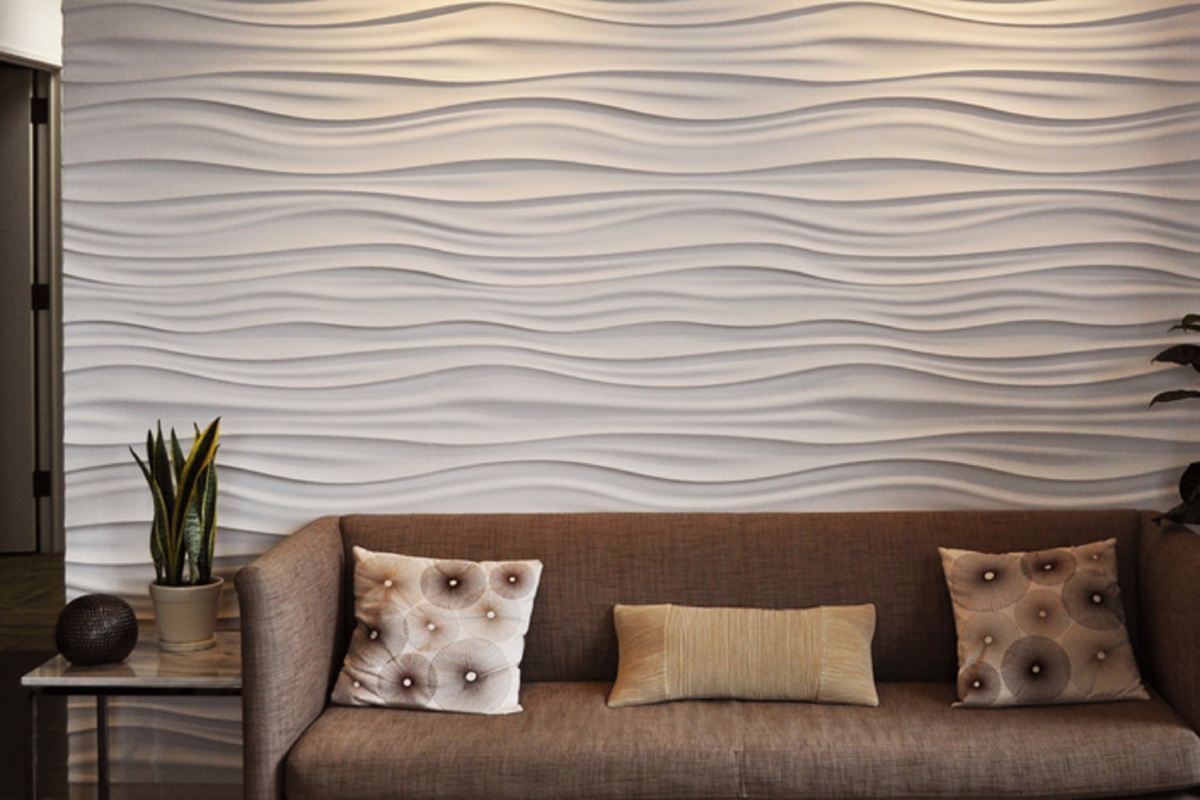
Wavy 3D panel in the interior of the room

Room interior with 3D panel

White 3D panel in the room
It is recommended to think over how the drawing will be located in advance. To do this, first estimate on a horizontal surface how it will look.
If the installation is done on your own, then give preference to decorative panels having special grooves for fasteners, so you will achieve more dense joints.
Pay attention to the panels made to order. With their help, you can create a truly unique design suitable for decorating your interior in all respects.
Summary
To radically change the interior without large material investments, it is enough to use decorative 3D panels for walls. They have a lot of undeniable advantages, they look stylish and visually expand the room, and the ease of installation and ease of use of plates with the effect of volume will make repairs easy and interesting.
Video: 3D panels - overview and installation instructions
